Organizational Culture Analysis and Recommendations: Inquirer Report
VerifiedAdded on 2020/03/23
|11
|2254
|51
Report
AI Summary
This report provides a comprehensive analysis of the organizational culture within the Philippine Daily Inquirer. It identifies key problems such as ineffective leadership styles (micromanagement), poor employee engagement, resistance to change, and a hierarchical organizational structure. The report delves into the root causes of these issues, examining the impact of the company's culture on its ability to compete with online news media. Using organizational theories like Goodall's organizational culture theory and Lewin's Change Management Model, the analysis highlights the negative consequences of the current practices. The report recommends a shift towards a clan culture, the adoption of transformational leadership, and a flexible organizational structure. It also suggests strategies to foster employee collaboration and address resistance to change through improved communication and interactive activities. The goal is to help the Inquirer adapt to the changing media landscape and improve overall performance and employee satisfaction.
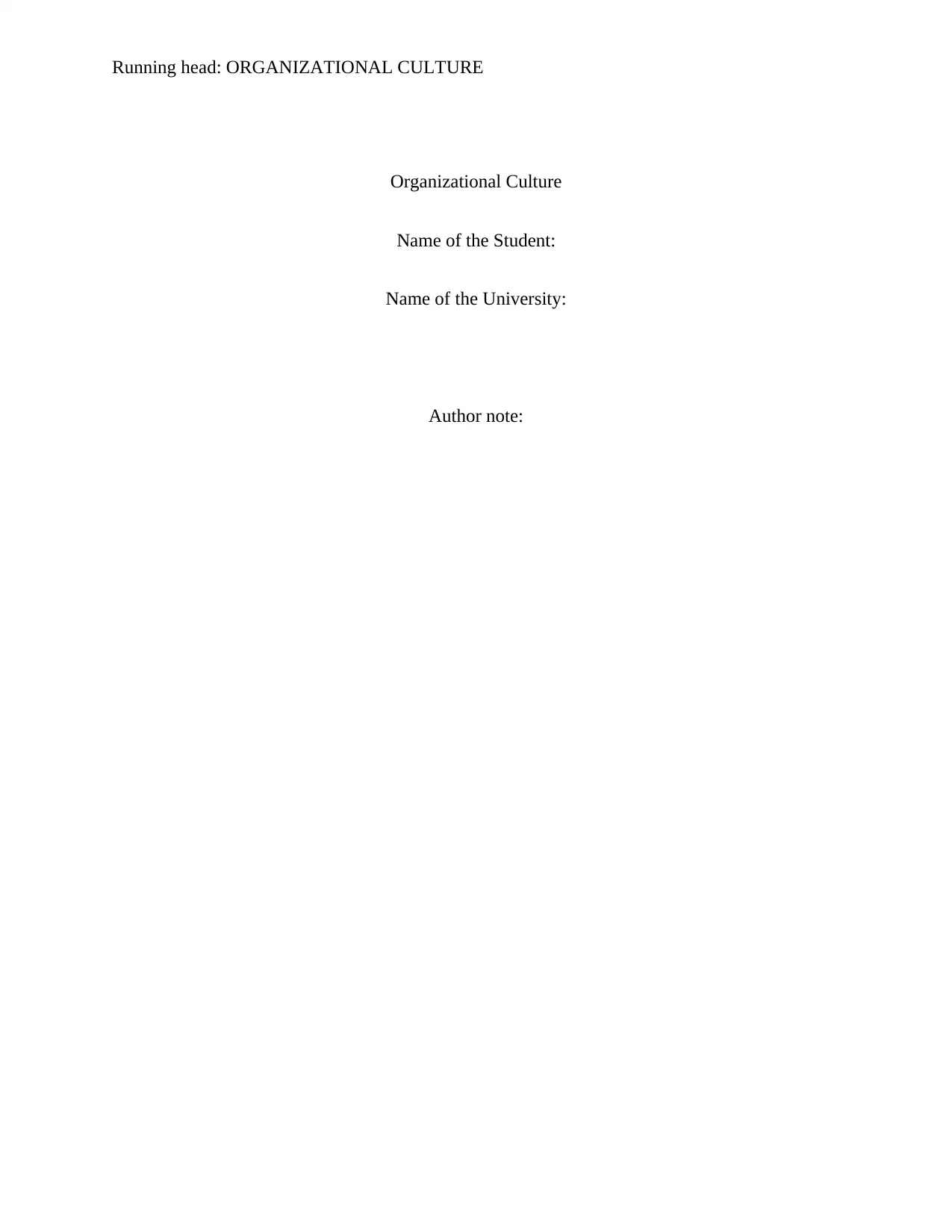
Running head: ORGANIZATIONAL CULTURE
Organizational Culture
Name of the Student:
Name of the University:
Author note:
Organizational Culture
Name of the Student:
Name of the University:
Author note:
Paraphrase This Document
Need a fresh take? Get an instant paraphrase of this document with our AI Paraphraser
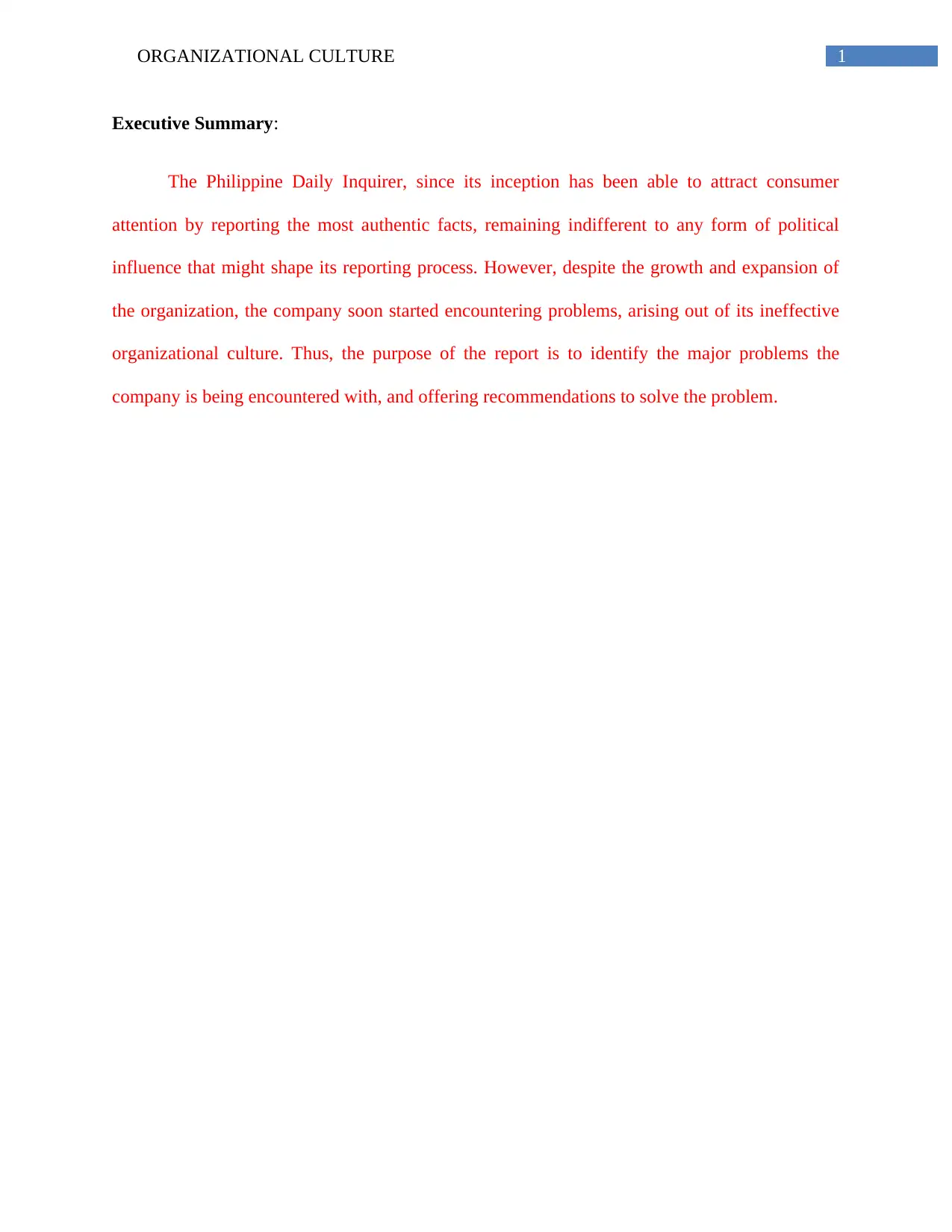
1ORGANIZATIONAL CULTURE
Executive Summary:
The Philippine Daily Inquirer, since its inception has been able to attract consumer
attention by reporting the most authentic facts, remaining indifferent to any form of political
influence that might shape its reporting process. However, despite the growth and expansion of
the organization, the company soon started encountering problems, arising out of its ineffective
organizational culture. Thus, the purpose of the report is to identify the major problems the
company is being encountered with, and offering recommendations to solve the problem.
Executive Summary:
The Philippine Daily Inquirer, since its inception has been able to attract consumer
attention by reporting the most authentic facts, remaining indifferent to any form of political
influence that might shape its reporting process. However, despite the growth and expansion of
the organization, the company soon started encountering problems, arising out of its ineffective
organizational culture. Thus, the purpose of the report is to identify the major problems the
company is being encountered with, and offering recommendations to solve the problem.
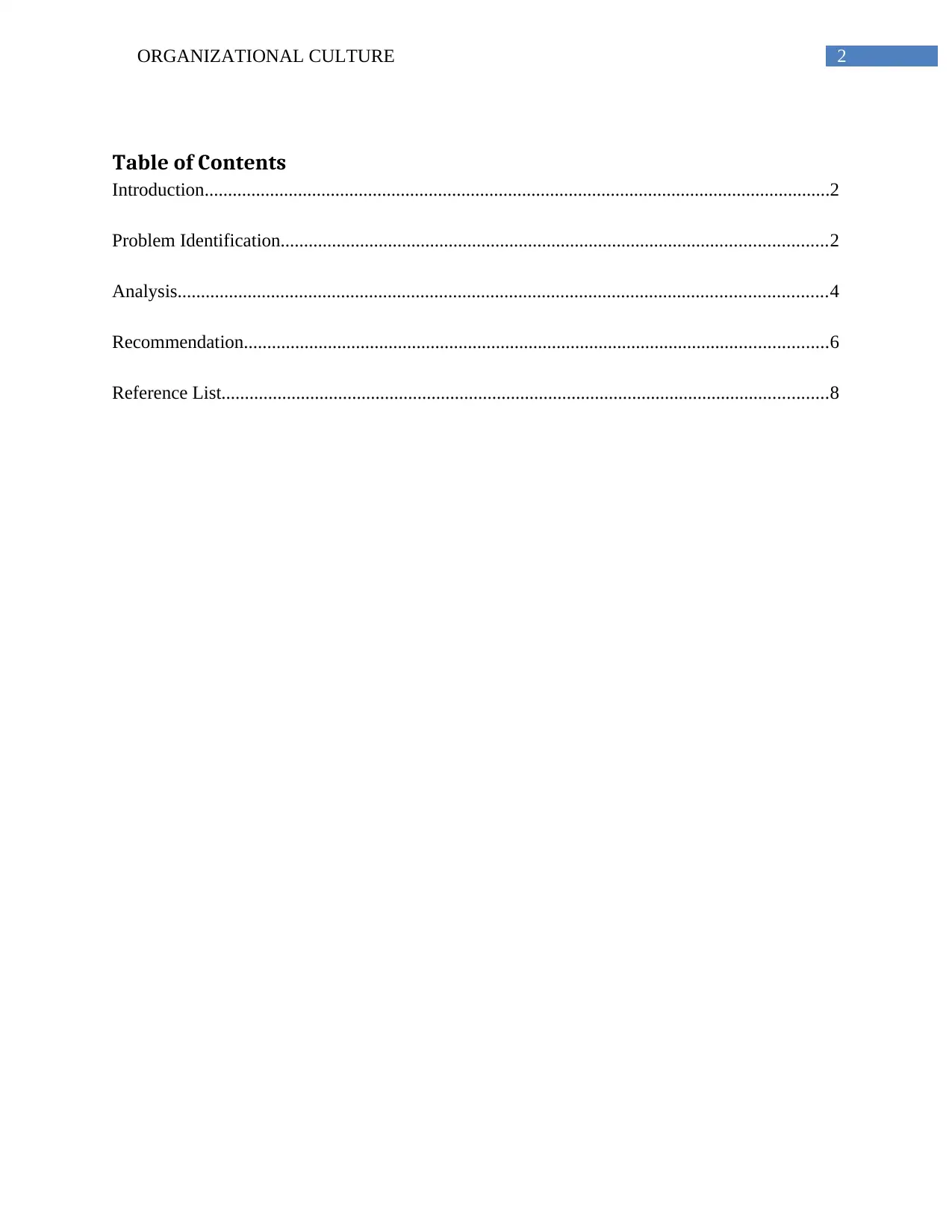
2ORGANIZATIONAL CULTURE
Table of Contents
Introduction......................................................................................................................................2
Problem Identification.....................................................................................................................2
Analysis...........................................................................................................................................4
Recommendation.............................................................................................................................6
Reference List..................................................................................................................................8
Table of Contents
Introduction......................................................................................................................................2
Problem Identification.....................................................................................................................2
Analysis...........................................................................................................................................4
Recommendation.............................................................................................................................6
Reference List..................................................................................................................................8
⊘ This is a preview!⊘
Do you want full access?
Subscribe today to unlock all pages.

Trusted by 1+ million students worldwide
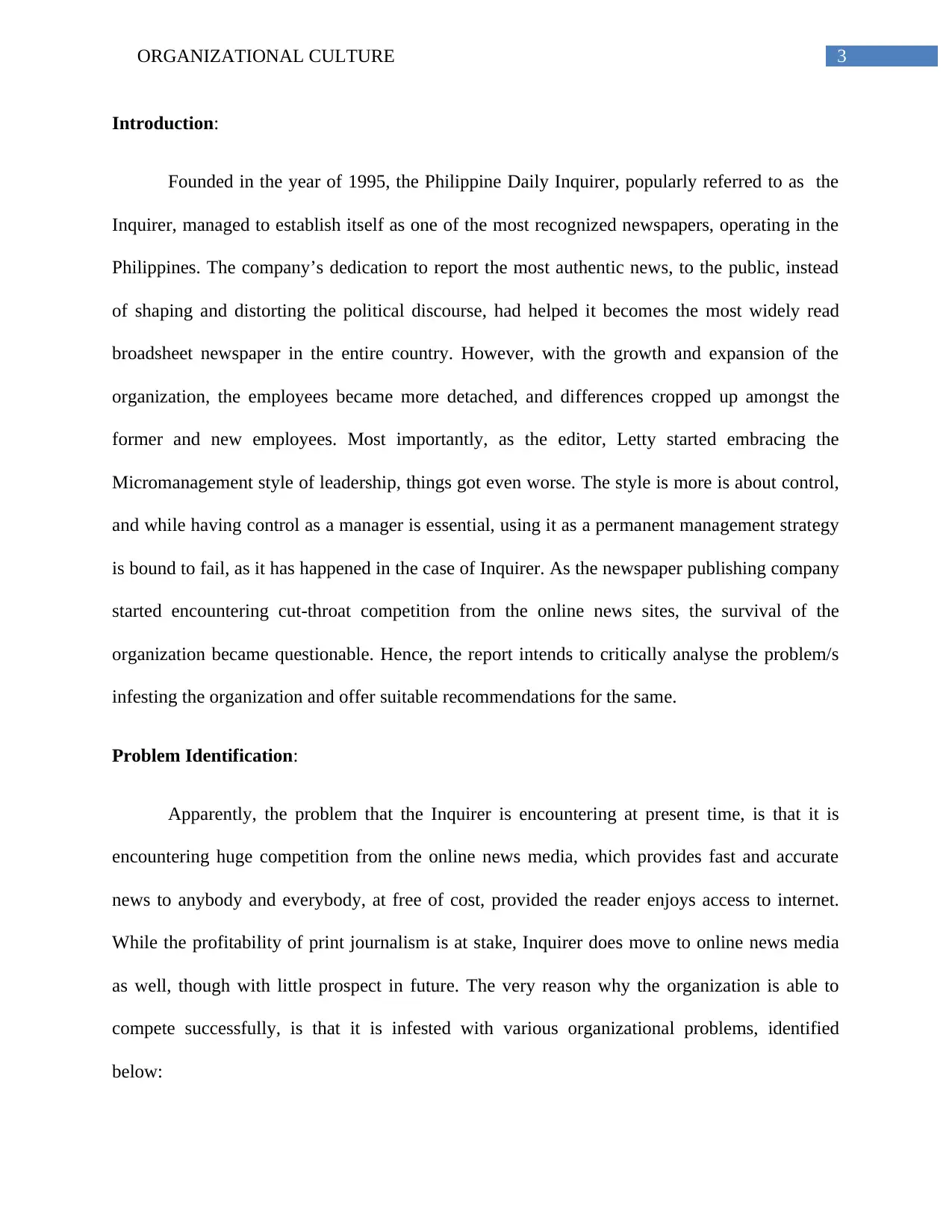
3ORGANIZATIONAL CULTURE
Introduction:
Founded in the year of 1995, the Philippine Daily Inquirer, popularly referred to as the
Inquirer, managed to establish itself as one of the most recognized newspapers, operating in the
Philippines. The company’s dedication to report the most authentic news, to the public, instead
of shaping and distorting the political discourse, had helped it becomes the most widely read
broadsheet newspaper in the entire country. However, with the growth and expansion of the
organization, the employees became more detached, and differences cropped up amongst the
former and new employees. Most importantly, as the editor, Letty started embracing the
Micromanagement style of leadership, things got even worse. The style is more is about control,
and while having control as a manager is essential, using it as a permanent management strategy
is bound to fail, as it has happened in the case of Inquirer. As the newspaper publishing company
started encountering cut-throat competition from the online news sites, the survival of the
organization became questionable. Hence, the report intends to critically analyse the problem/s
infesting the organization and offer suitable recommendations for the same.
Problem Identification:
Apparently, the problem that the Inquirer is encountering at present time, is that it is
encountering huge competition from the online news media, which provides fast and accurate
news to anybody and everybody, at free of cost, provided the reader enjoys access to internet.
While the profitability of print journalism is at stake, Inquirer does move to online news media
as well, though with little prospect in future. The very reason why the organization is able to
compete successfully, is that it is infested with various organizational problems, identified
below:
Introduction:
Founded in the year of 1995, the Philippine Daily Inquirer, popularly referred to as the
Inquirer, managed to establish itself as one of the most recognized newspapers, operating in the
Philippines. The company’s dedication to report the most authentic news, to the public, instead
of shaping and distorting the political discourse, had helped it becomes the most widely read
broadsheet newspaper in the entire country. However, with the growth and expansion of the
organization, the employees became more detached, and differences cropped up amongst the
former and new employees. Most importantly, as the editor, Letty started embracing the
Micromanagement style of leadership, things got even worse. The style is more is about control,
and while having control as a manager is essential, using it as a permanent management strategy
is bound to fail, as it has happened in the case of Inquirer. As the newspaper publishing company
started encountering cut-throat competition from the online news sites, the survival of the
organization became questionable. Hence, the report intends to critically analyse the problem/s
infesting the organization and offer suitable recommendations for the same.
Problem Identification:
Apparently, the problem that the Inquirer is encountering at present time, is that it is
encountering huge competition from the online news media, which provides fast and accurate
news to anybody and everybody, at free of cost, provided the reader enjoys access to internet.
While the profitability of print journalism is at stake, Inquirer does move to online news media
as well, though with little prospect in future. The very reason why the organization is able to
compete successfully, is that it is infested with various organizational problems, identified
below:
Paraphrase This Document
Need a fresh take? Get an instant paraphrase of this document with our AI Paraphraser
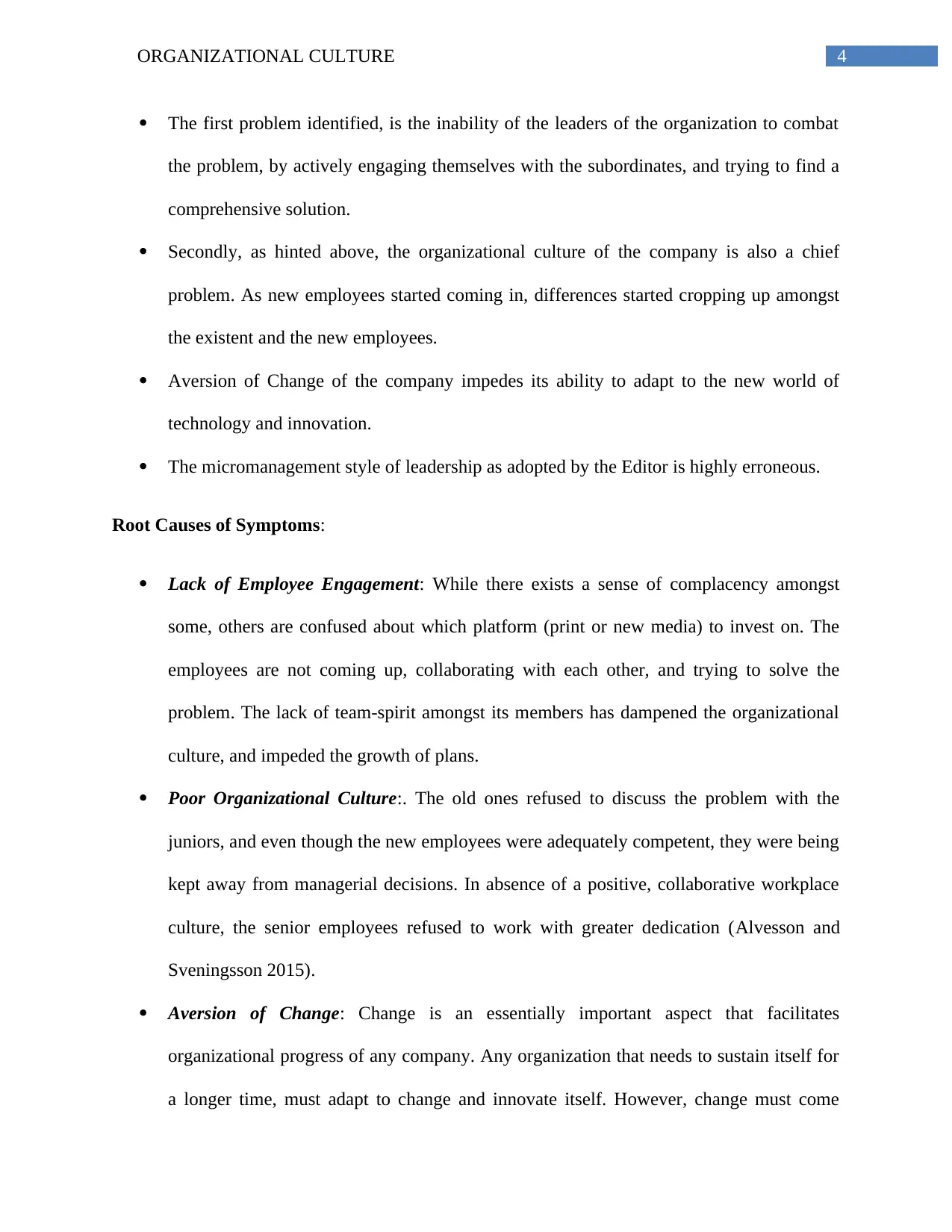
4ORGANIZATIONAL CULTURE
The first problem identified, is the inability of the leaders of the organization to combat
the problem, by actively engaging themselves with the subordinates, and trying to find a
comprehensive solution.
Secondly, as hinted above, the organizational culture of the company is also a chief
problem. As new employees started coming in, differences started cropping up amongst
the existent and the new employees.
Aversion of Change of the company impedes its ability to adapt to the new world of
technology and innovation.
The micromanagement style of leadership as adopted by the Editor is highly erroneous.
Root Causes of Symptoms:
Lack of Employee Engagement: While there exists a sense of complacency amongst
some, others are confused about which platform (print or new media) to invest on. The
employees are not coming up, collaborating with each other, and trying to solve the
problem. The lack of team-spirit amongst its members has dampened the organizational
culture, and impeded the growth of plans.
Poor Organizational Culture:. The old ones refused to discuss the problem with the
juniors, and even though the new employees were adequately competent, they were being
kept away from managerial decisions. In absence of a positive, collaborative workplace
culture, the senior employees refused to work with greater dedication (Alvesson and
Sveningsson 2015).
Aversion of Change: Change is an essentially important aspect that facilitates
organizational progress of any company. Any organization that needs to sustain itself for
a longer time, must adapt to change and innovate itself. However, change must come
The first problem identified, is the inability of the leaders of the organization to combat
the problem, by actively engaging themselves with the subordinates, and trying to find a
comprehensive solution.
Secondly, as hinted above, the organizational culture of the company is also a chief
problem. As new employees started coming in, differences started cropping up amongst
the existent and the new employees.
Aversion of Change of the company impedes its ability to adapt to the new world of
technology and innovation.
The micromanagement style of leadership as adopted by the Editor is highly erroneous.
Root Causes of Symptoms:
Lack of Employee Engagement: While there exists a sense of complacency amongst
some, others are confused about which platform (print or new media) to invest on. The
employees are not coming up, collaborating with each other, and trying to solve the
problem. The lack of team-spirit amongst its members has dampened the organizational
culture, and impeded the growth of plans.
Poor Organizational Culture:. The old ones refused to discuss the problem with the
juniors, and even though the new employees were adequately competent, they were being
kept away from managerial decisions. In absence of a positive, collaborative workplace
culture, the senior employees refused to work with greater dedication (Alvesson and
Sveningsson 2015).
Aversion of Change: Change is an essentially important aspect that facilitates
organizational progress of any company. Any organization that needs to sustain itself for
a longer time, must adapt to change and innovate itself. However, change must come
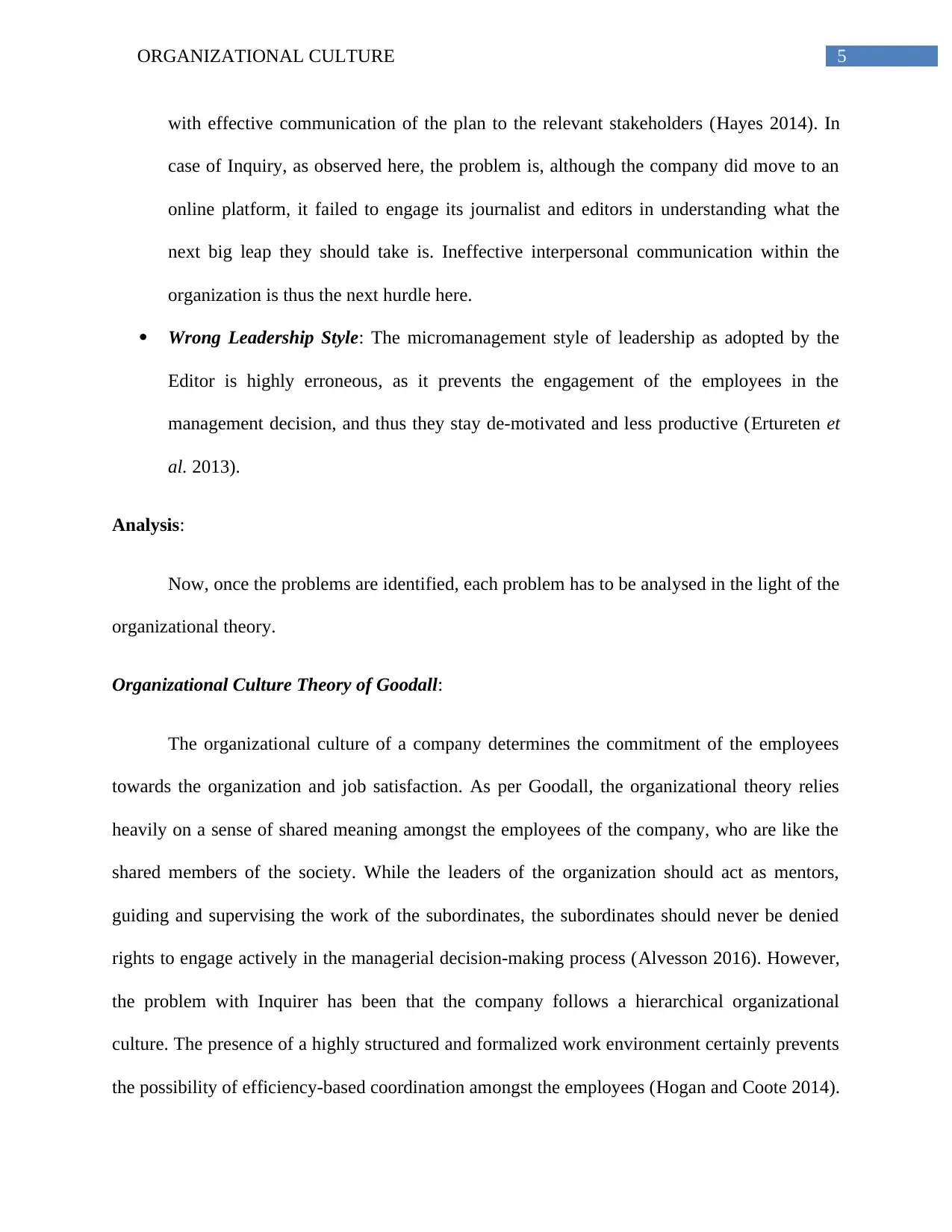
5ORGANIZATIONAL CULTURE
with effective communication of the plan to the relevant stakeholders (Hayes 2014). In
case of Inquiry, as observed here, the problem is, although the company did move to an
online platform, it failed to engage its journalist and editors in understanding what the
next big leap they should take is. Ineffective interpersonal communication within the
organization is thus the next hurdle here.
Wrong Leadership Style: The micromanagement style of leadership as adopted by the
Editor is highly erroneous, as it prevents the engagement of the employees in the
management decision, and thus they stay de-motivated and less productive (Ertureten et
al. 2013).
Analysis:
Now, once the problems are identified, each problem has to be analysed in the light of the
organizational theory.
Organizational Culture Theory of Goodall:
The organizational culture of a company determines the commitment of the employees
towards the organization and job satisfaction. As per Goodall, the organizational theory relies
heavily on a sense of shared meaning amongst the employees of the company, who are like the
shared members of the society. While the leaders of the organization should act as mentors,
guiding and supervising the work of the subordinates, the subordinates should never be denied
rights to engage actively in the managerial decision-making process (Alvesson 2016). However,
the problem with Inquirer has been that the company follows a hierarchical organizational
culture. The presence of a highly structured and formalized work environment certainly prevents
the possibility of efficiency-based coordination amongst the employees (Hogan and Coote 2014).
with effective communication of the plan to the relevant stakeholders (Hayes 2014). In
case of Inquiry, as observed here, the problem is, although the company did move to an
online platform, it failed to engage its journalist and editors in understanding what the
next big leap they should take is. Ineffective interpersonal communication within the
organization is thus the next hurdle here.
Wrong Leadership Style: The micromanagement style of leadership as adopted by the
Editor is highly erroneous, as it prevents the engagement of the employees in the
management decision, and thus they stay de-motivated and less productive (Ertureten et
al. 2013).
Analysis:
Now, once the problems are identified, each problem has to be analysed in the light of the
organizational theory.
Organizational Culture Theory of Goodall:
The organizational culture of a company determines the commitment of the employees
towards the organization and job satisfaction. As per Goodall, the organizational theory relies
heavily on a sense of shared meaning amongst the employees of the company, who are like the
shared members of the society. While the leaders of the organization should act as mentors,
guiding and supervising the work of the subordinates, the subordinates should never be denied
rights to engage actively in the managerial decision-making process (Alvesson 2016). However,
the problem with Inquirer has been that the company follows a hierarchical organizational
culture. The presence of a highly structured and formalized work environment certainly prevents
the possibility of efficiency-based coordination amongst the employees (Hogan and Coote 2014).
⊘ This is a preview!⊘
Do you want full access?
Subscribe today to unlock all pages.

Trusted by 1+ million students worldwide
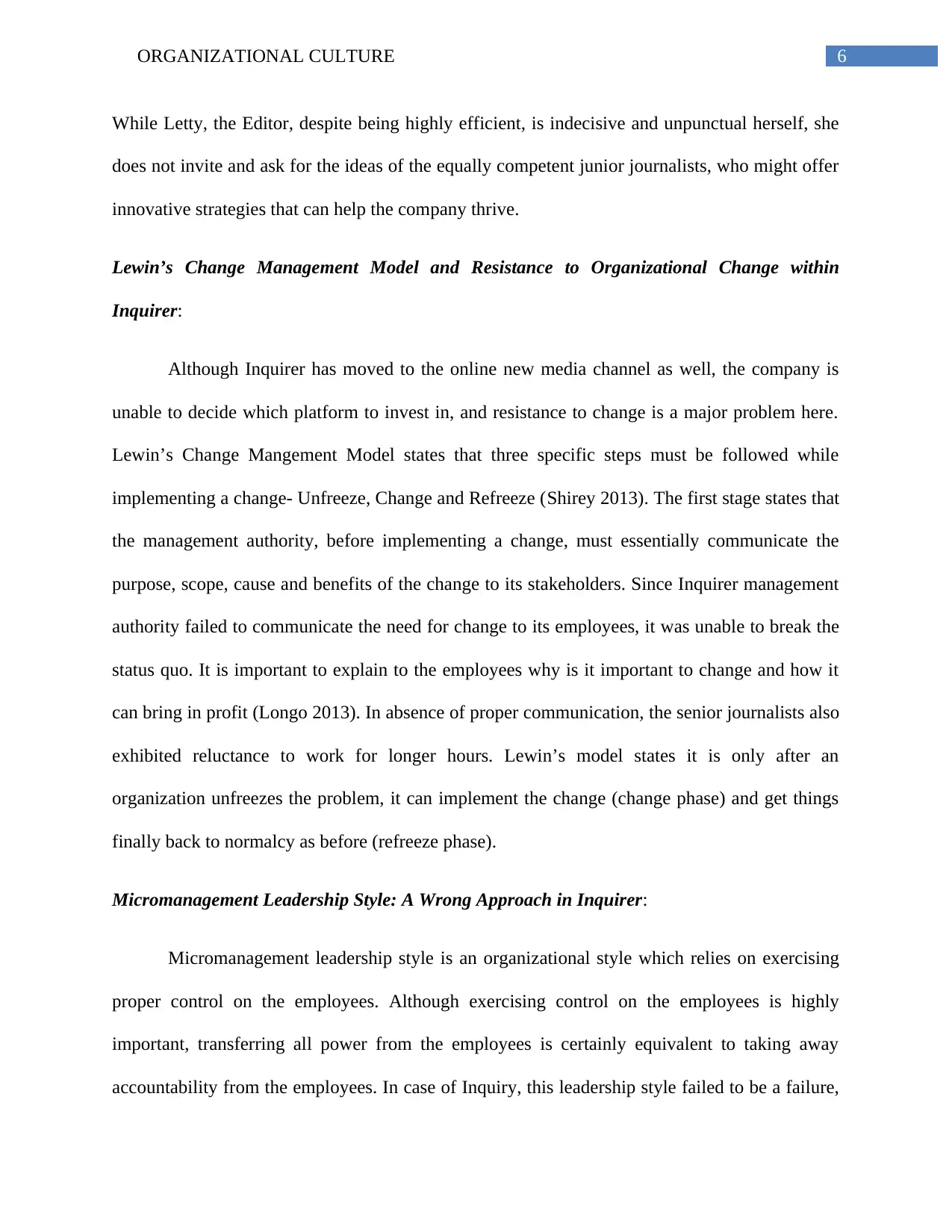
6ORGANIZATIONAL CULTURE
While Letty, the Editor, despite being highly efficient, is indecisive and unpunctual herself, she
does not invite and ask for the ideas of the equally competent junior journalists, who might offer
innovative strategies that can help the company thrive.
Lewin’s Change Management Model and Resistance to Organizational Change within
Inquirer:
Although Inquirer has moved to the online new media channel as well, the company is
unable to decide which platform to invest in, and resistance to change is a major problem here.
Lewin’s Change Mangement Model states that three specific steps must be followed while
implementing a change- Unfreeze, Change and Refreeze (Shirey 2013). The first stage states that
the management authority, before implementing a change, must essentially communicate the
purpose, scope, cause and benefits of the change to its stakeholders. Since Inquirer management
authority failed to communicate the need for change to its employees, it was unable to break the
status quo. It is important to explain to the employees why is it important to change and how it
can bring in profit (Longo 2013). In absence of proper communication, the senior journalists also
exhibited reluctance to work for longer hours. Lewin’s model states it is only after an
organization unfreezes the problem, it can implement the change (change phase) and get things
finally back to normalcy as before (refreeze phase).
Micromanagement Leadership Style: A Wrong Approach in Inquirer:
Micromanagement leadership style is an organizational style which relies on exercising
proper control on the employees. Although exercising control on the employees is highly
important, transferring all power from the employees is certainly equivalent to taking away
accountability from the employees. In case of Inquiry, this leadership style failed to be a failure,
While Letty, the Editor, despite being highly efficient, is indecisive and unpunctual herself, she
does not invite and ask for the ideas of the equally competent junior journalists, who might offer
innovative strategies that can help the company thrive.
Lewin’s Change Management Model and Resistance to Organizational Change within
Inquirer:
Although Inquirer has moved to the online new media channel as well, the company is
unable to decide which platform to invest in, and resistance to change is a major problem here.
Lewin’s Change Mangement Model states that three specific steps must be followed while
implementing a change- Unfreeze, Change and Refreeze (Shirey 2013). The first stage states that
the management authority, before implementing a change, must essentially communicate the
purpose, scope, cause and benefits of the change to its stakeholders. Since Inquirer management
authority failed to communicate the need for change to its employees, it was unable to break the
status quo. It is important to explain to the employees why is it important to change and how it
can bring in profit (Longo 2013). In absence of proper communication, the senior journalists also
exhibited reluctance to work for longer hours. Lewin’s model states it is only after an
organization unfreezes the problem, it can implement the change (change phase) and get things
finally back to normalcy as before (refreeze phase).
Micromanagement Leadership Style: A Wrong Approach in Inquirer:
Micromanagement leadership style is an organizational style which relies on exercising
proper control on the employees. Although exercising control on the employees is highly
important, transferring all power from the employees is certainly equivalent to taking away
accountability from the employees. In case of Inquiry, this leadership style failed to be a failure,
Paraphrase This Document
Need a fresh take? Get an instant paraphrase of this document with our AI Paraphraser
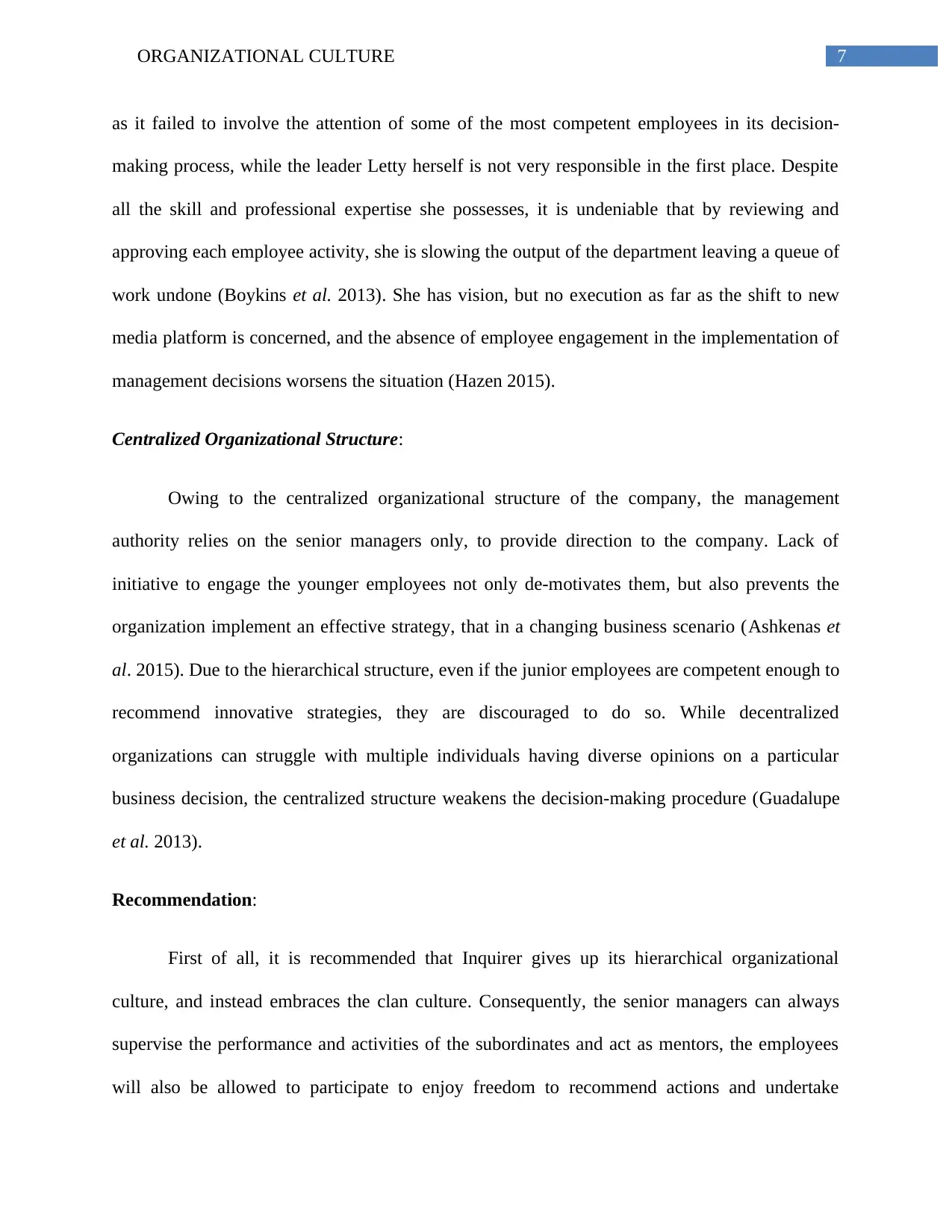
7ORGANIZATIONAL CULTURE
as it failed to involve the attention of some of the most competent employees in its decision-
making process, while the leader Letty herself is not very responsible in the first place. Despite
all the skill and professional expertise she possesses, it is undeniable that by reviewing and
approving each employee activity, she is slowing the output of the department leaving a queue of
work undone (Boykins et al. 2013). She has vision, but no execution as far as the shift to new
media platform is concerned, and the absence of employee engagement in the implementation of
management decisions worsens the situation (Hazen 2015).
Centralized Organizational Structure:
Owing to the centralized organizational structure of the company, the management
authority relies on the senior managers only, to provide direction to the company. Lack of
initiative to engage the younger employees not only de-motivates them, but also prevents the
organization implement an effective strategy, that in a changing business scenario (Ashkenas et
al. 2015). Due to the hierarchical structure, even if the junior employees are competent enough to
recommend innovative strategies, they are discouraged to do so. While decentralized
organizations can struggle with multiple individuals having diverse opinions on a particular
business decision, the centralized structure weakens the decision-making procedure (Guadalupe
et al. 2013).
Recommendation:
First of all, it is recommended that Inquirer gives up its hierarchical organizational
culture, and instead embraces the clan culture. Consequently, the senior managers can always
supervise the performance and activities of the subordinates and act as mentors, the employees
will also be allowed to participate to enjoy freedom to recommend actions and undertake
as it failed to involve the attention of some of the most competent employees in its decision-
making process, while the leader Letty herself is not very responsible in the first place. Despite
all the skill and professional expertise she possesses, it is undeniable that by reviewing and
approving each employee activity, she is slowing the output of the department leaving a queue of
work undone (Boykins et al. 2013). She has vision, but no execution as far as the shift to new
media platform is concerned, and the absence of employee engagement in the implementation of
management decisions worsens the situation (Hazen 2015).
Centralized Organizational Structure:
Owing to the centralized organizational structure of the company, the management
authority relies on the senior managers only, to provide direction to the company. Lack of
initiative to engage the younger employees not only de-motivates them, but also prevents the
organization implement an effective strategy, that in a changing business scenario (Ashkenas et
al. 2015). Due to the hierarchical structure, even if the junior employees are competent enough to
recommend innovative strategies, they are discouraged to do so. While decentralized
organizations can struggle with multiple individuals having diverse opinions on a particular
business decision, the centralized structure weakens the decision-making procedure (Guadalupe
et al. 2013).
Recommendation:
First of all, it is recommended that Inquirer gives up its hierarchical organizational
culture, and instead embraces the clan culture. Consequently, the senior managers can always
supervise the performance and activities of the subordinates and act as mentors, the employees
will also be allowed to participate to enjoy freedom to recommend actions and undertake
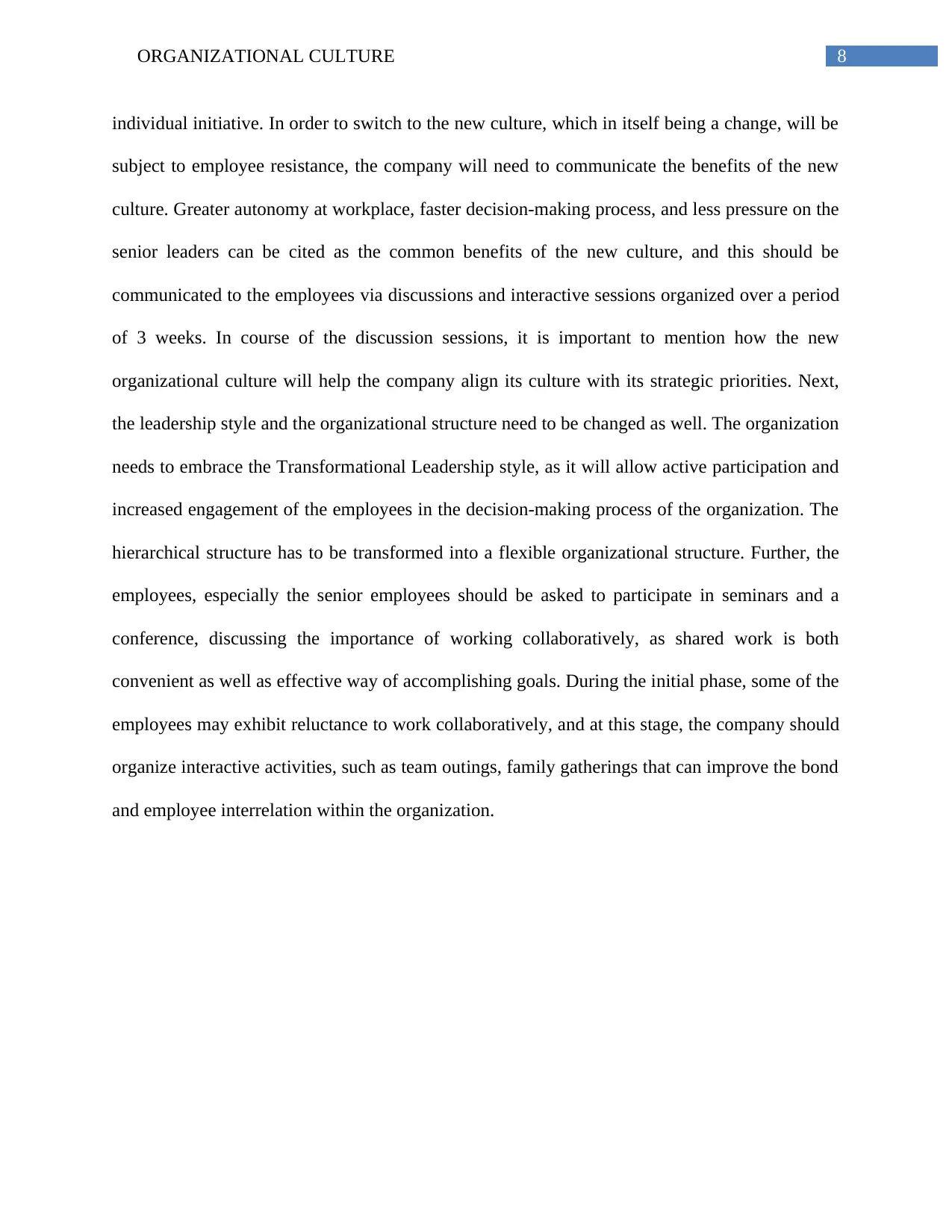
8ORGANIZATIONAL CULTURE
individual initiative. In order to switch to the new culture, which in itself being a change, will be
subject to employee resistance, the company will need to communicate the benefits of the new
culture. Greater autonomy at workplace, faster decision-making process, and less pressure on the
senior leaders can be cited as the common benefits of the new culture, and this should be
communicated to the employees via discussions and interactive sessions organized over a period
of 3 weeks. In course of the discussion sessions, it is important to mention how the new
organizational culture will help the company align its culture with its strategic priorities. Next,
the leadership style and the organizational structure need to be changed as well. The organization
needs to embrace the Transformational Leadership style, as it will allow active participation and
increased engagement of the employees in the decision-making process of the organization. The
hierarchical structure has to be transformed into a flexible organizational structure. Further, the
employees, especially the senior employees should be asked to participate in seminars and a
conference, discussing the importance of working collaboratively, as shared work is both
convenient as well as effective way of accomplishing goals. During the initial phase, some of the
employees may exhibit reluctance to work collaboratively, and at this stage, the company should
organize interactive activities, such as team outings, family gatherings that can improve the bond
and employee interrelation within the organization.
individual initiative. In order to switch to the new culture, which in itself being a change, will be
subject to employee resistance, the company will need to communicate the benefits of the new
culture. Greater autonomy at workplace, faster decision-making process, and less pressure on the
senior leaders can be cited as the common benefits of the new culture, and this should be
communicated to the employees via discussions and interactive sessions organized over a period
of 3 weeks. In course of the discussion sessions, it is important to mention how the new
organizational culture will help the company align its culture with its strategic priorities. Next,
the leadership style and the organizational structure need to be changed as well. The organization
needs to embrace the Transformational Leadership style, as it will allow active participation and
increased engagement of the employees in the decision-making process of the organization. The
hierarchical structure has to be transformed into a flexible organizational structure. Further, the
employees, especially the senior employees should be asked to participate in seminars and a
conference, discussing the importance of working collaboratively, as shared work is both
convenient as well as effective way of accomplishing goals. During the initial phase, some of the
employees may exhibit reluctance to work collaboratively, and at this stage, the company should
organize interactive activities, such as team outings, family gatherings that can improve the bond
and employee interrelation within the organization.
⊘ This is a preview!⊘
Do you want full access?
Subscribe today to unlock all pages.

Trusted by 1+ million students worldwide
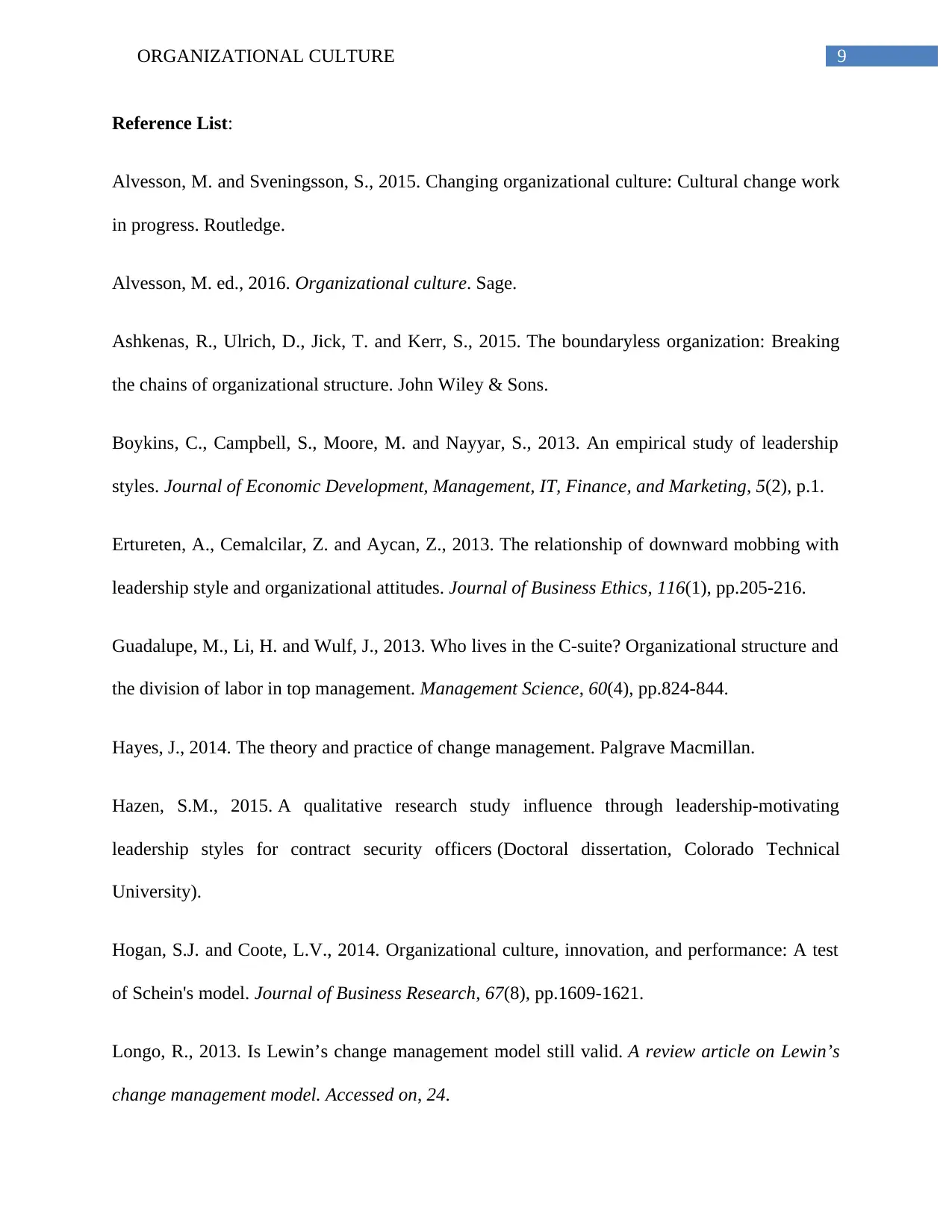
9ORGANIZATIONAL CULTURE
Reference List:
Alvesson, M. and Sveningsson, S., 2015. Changing organizational culture: Cultural change work
in progress. Routledge.
Alvesson, M. ed., 2016. Organizational culture. Sage.
Ashkenas, R., Ulrich, D., Jick, T. and Kerr, S., 2015. The boundaryless organization: Breaking
the chains of organizational structure. John Wiley & Sons.
Boykins, C., Campbell, S., Moore, M. and Nayyar, S., 2013. An empirical study of leadership
styles. Journal of Economic Development, Management, IT, Finance, and Marketing, 5(2), p.1.
Ertureten, A., Cemalcilar, Z. and Aycan, Z., 2013. The relationship of downward mobbing with
leadership style and organizational attitudes. Journal of Business Ethics, 116(1), pp.205-216.
Guadalupe, M., Li, H. and Wulf, J., 2013. Who lives in the C-suite? Organizational structure and
the division of labor in top management. Management Science, 60(4), pp.824-844.
Hayes, J., 2014. The theory and practice of change management. Palgrave Macmillan.
Hazen, S.M., 2015. A qualitative research study influence through leadership-motivating
leadership styles for contract security officers (Doctoral dissertation, Colorado Technical
University).
Hogan, S.J. and Coote, L.V., 2014. Organizational culture, innovation, and performance: A test
of Schein's model. Journal of Business Research, 67(8), pp.1609-1621.
Longo, R., 2013. Is Lewin’s change management model still valid. A review article on Lewin’s
change management model. Accessed on, 24.
Reference List:
Alvesson, M. and Sveningsson, S., 2015. Changing organizational culture: Cultural change work
in progress. Routledge.
Alvesson, M. ed., 2016. Organizational culture. Sage.
Ashkenas, R., Ulrich, D., Jick, T. and Kerr, S., 2015. The boundaryless organization: Breaking
the chains of organizational structure. John Wiley & Sons.
Boykins, C., Campbell, S., Moore, M. and Nayyar, S., 2013. An empirical study of leadership
styles. Journal of Economic Development, Management, IT, Finance, and Marketing, 5(2), p.1.
Ertureten, A., Cemalcilar, Z. and Aycan, Z., 2013. The relationship of downward mobbing with
leadership style and organizational attitudes. Journal of Business Ethics, 116(1), pp.205-216.
Guadalupe, M., Li, H. and Wulf, J., 2013. Who lives in the C-suite? Organizational structure and
the division of labor in top management. Management Science, 60(4), pp.824-844.
Hayes, J., 2014. The theory and practice of change management. Palgrave Macmillan.
Hazen, S.M., 2015. A qualitative research study influence through leadership-motivating
leadership styles for contract security officers (Doctoral dissertation, Colorado Technical
University).
Hogan, S.J. and Coote, L.V., 2014. Organizational culture, innovation, and performance: A test
of Schein's model. Journal of Business Research, 67(8), pp.1609-1621.
Longo, R., 2013. Is Lewin’s change management model still valid. A review article on Lewin’s
change management model. Accessed on, 24.
Paraphrase This Document
Need a fresh take? Get an instant paraphrase of this document with our AI Paraphraser
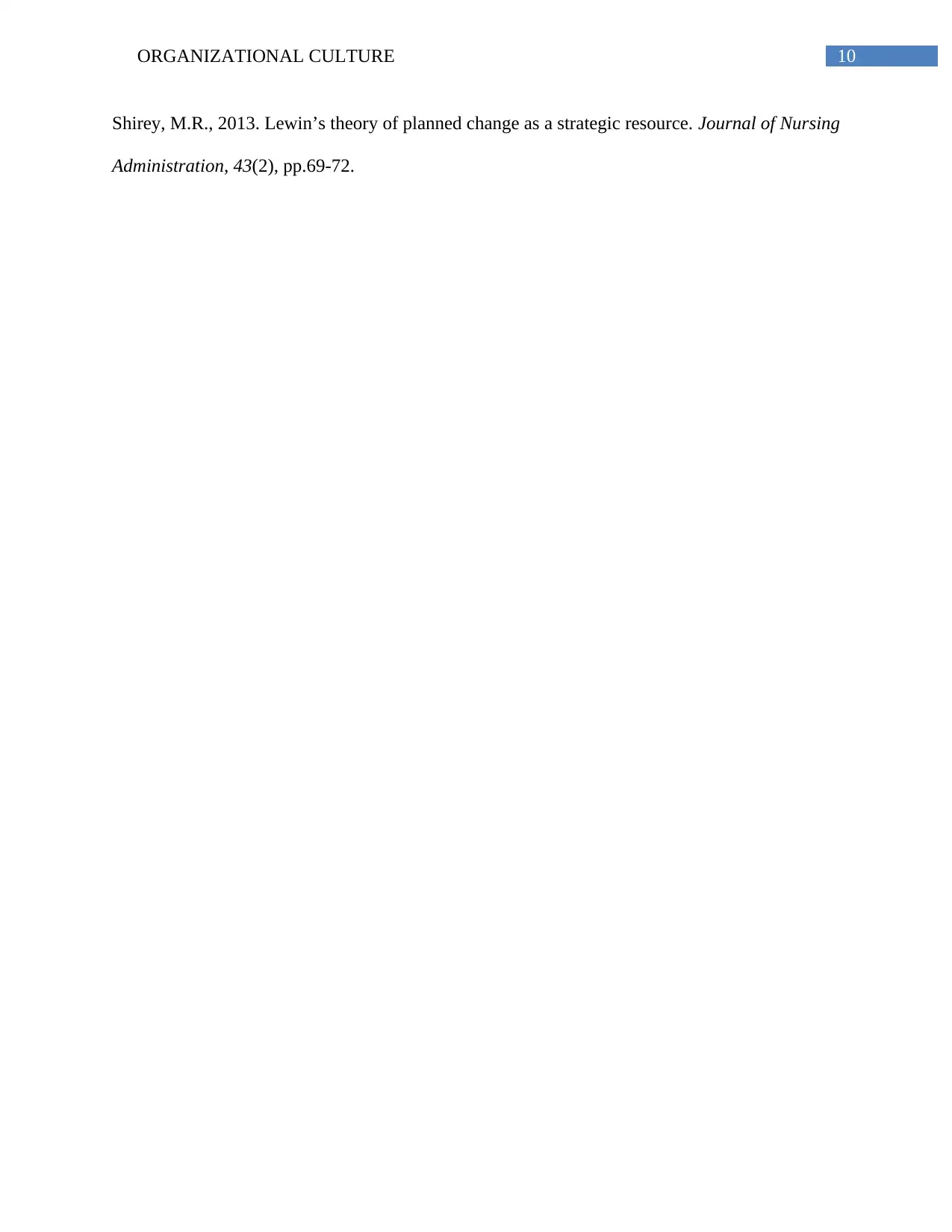
10ORGANIZATIONAL CULTURE
Shirey, M.R., 2013. Lewin’s theory of planned change as a strategic resource. Journal of Nursing
Administration, 43(2), pp.69-72.
Shirey, M.R., 2013. Lewin’s theory of planned change as a strategic resource. Journal of Nursing
Administration, 43(2), pp.69-72.
1 out of 11
Related Documents
Your All-in-One AI-Powered Toolkit for Academic Success.
+13062052269
info@desklib.com
Available 24*7 on WhatsApp / Email
![[object Object]](/_next/static/media/star-bottom.7253800d.svg)
Unlock your academic potential
Copyright © 2020–2025 A2Z Services. All Rights Reserved. Developed and managed by ZUCOL.





